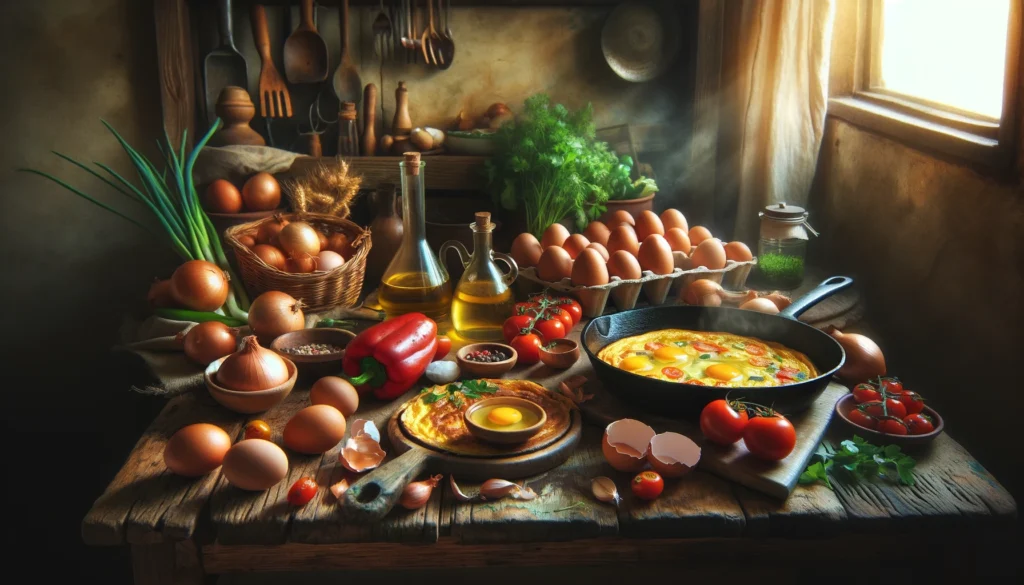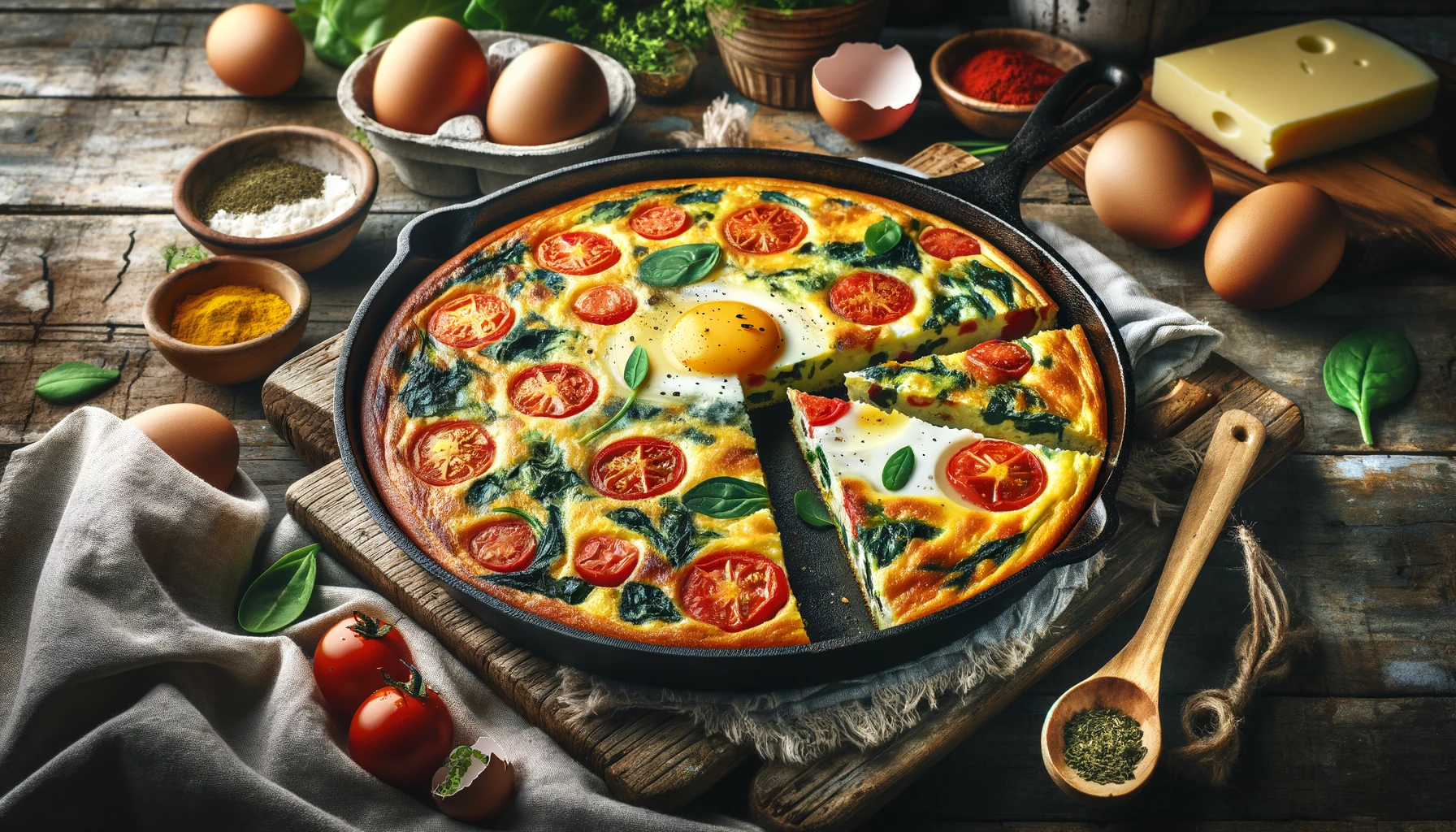Looking to whip up something delicious for your next meal? Why not try your hand at mastering the art of the Italian Frittata Recipe? This versatile dish, akin to an omelette, combines eggs with an array of ingredients like vegetables, cheeses, and meats, creating a savory delight that’s perfect for any time of day. Whether you’re craving a hearty breakfast, a leisurely brunch, or a satisfying dinner, the Italian Frittata Recipe fits the bill perfectly. Plus, it’s an excellent way to use up leftover ingredients, adding a touch of creativity to your culinary endeavors. So grab your skillet and get ready to impress with this timeless Italian classic.
Discuss the origins of the frittata in Italian cuisine.
The frittata is a classic dish in Italian cuisine, with a history dating back centuries. Its origins are rooted in the Italian tradition of cucina povera, or “poor cooking,” where simple and inexpensive ingredients are transformed into delicious meals.
The word “frittata” itself comes from the Italian verb “friggere,” meaning “to fry,” highlighting the cooking method of frying beaten eggs with various ingredients.
Frittatas are indeed a versatile dish; in fact, they incorporate a variety of ingredients such as vegetables, meats, cheeses, and herbs. They are often served as a main course, especially in Italy’s rural regions, where families commonly enjoy them at gatherings and celebrations.
One of the most traditional occasions for serving frittatas is during Easter; during this time, they symbolize rebirth and renewal, reflecting the seasonal ingredients used in spring.
In general, the frittata is not just a dish in Italian cuisine; rather, it is a cultural symbol, representing the simplicity, creativity, and resourcefulness of Italian cooking. Speaking of which, let me share with you an authentic Italian Frittata Recipe that captures the essence of this culinary tradition.
Ingredients for Italian Frittata
Italian Frittata is a versatile and delicious dish that can be made with a variety of ingredients. Here’s a list of common ingredients used in making a traditional Italian frittata, along with some variations and regional differences. Whether you’re opting for a classic spinach and cheese combination or exploring more adventurous flavors like sun-dried tomatoes and basil, mastering the art of the Italian Frittata recipe opens up a world of culinary creativity:
- Eggs: The base of any frittata is eggs. Typically, 6-8 eggs are used for a standard frittata.
- Vegetables: Common vegetables used in a frittata include onions, bell peppers, zucchini, mushrooms, and tomatoes. These can be sautéed before adding to the eggs.
- Cheese: Cheese adds richness and flavor to a frittata. Common cheeses used include Parmesan, Pecorino Romano, and Fontina. Ricotta and mozzarella are also popular choices.
- Meats: While not always included, meats such as pancetta, bacon, sausage, or ham can be added to a frittata for extra flavor and protein. These should be cooked before adding to the eggs.
- Herbs: Fresh herbs like parsley, basil, or thyme can be added to enhance the flavor of the frittata. Dried herbs can also be used.
- Seasonings: Salt, pepper, and sometimes a pinch of nutmeg are commonly used to season a frittata.

Variations and Regional Differences:
- Vegetarian: A vegetarian frittata excludes meats and focuses on vegetables and cheese for flavor.
- Mediterranean: This variation might include ingredients like olives, sun-dried tomatoes, and feta cheese.
- Spanish: A Spanish frittata, or “tortilla española,” often includes potatoes and onions.
- Regional Italian: Different regions of Italy have their own variations. For example, in Liguria, they might add pesto or artichokes, while in Sicily, they might include eggplant and ricotta salata.
Cooking Method:
- Beat the eggs in a bowl and season with salt, pepper, and any herbs you’re using.
- Heat oil in an oven-safe skillet and add any vegetables or meats you’re using, cooking until softened.
- Pour the beaten eggs over the vegetables and cook over low heat until the edges start to set.
- Sprinkle cheese over the top and transfer the skillet to a preheated oven.
- Bake until the frittata is set and slightly puffed up.
- Serve hot or at room temperature, cut into wedges.
Italian frittata is a perfect dish for any meal and can be enjoyed hot or cold, making it ideal for picnics or packed lunches.
How to Make Italian Frittata
To make a basic Italian frittata, you’ll need eggs, olive oil, salt, pepper, and any desired fillings like vegetables, cheese, or meats. Here’s a step-by-step guide:
- Prep Fillings: Chop any vegetables or meats you plan to use into small, uniform pieces. Grate any cheese.
- Whisk Eggs: In a bowl, whisk together eggs, salt, and pepper until well combined. Use about 2 eggs per serving.
- Cook Fillings: In an oven-safe skillet, heat olive oil over medium heat. Add any vegetables or meats and cook until softened and cooked through. Remove from skillet and set aside.
- Add Eggs: Pour the whisked eggs into the skillet with the cooked fillings. Gently stir to distribute the fillings evenly.
- Cook Frittata: Cook the frittata over medium-low heat without stirring for about 8-10 minutes, or until the edges are set but the center is still slightly runny.
- Flip or Broil (optional): If you’re comfortable flipping the frittata, place a plate over the skillet, invert the frittata onto the plate, then slide it back into the skillet to cook the other side for another 3-5 minutes. Alternatively, you can finish cooking the top under a broiler for a few minutes.
- Serve: Once the frittata is cooked through and set, remove it from the skillet and let it cool for a few minutes before slicing and serving.

Tips:
- Use a non-stick or well-seasoned cast iron skillet for easy flipping.
- For a fluffy frittata, beat the eggs vigorously before cooking.
- Customize your frittata with any fillings you like, such as spinach, tomatoes, mushrooms, or different cheeses.
- Serve the frittata warm or at room temperature, with a side salad or crusty bread.
Enjoy your homemade Italian frittata!
Variations of Italian Frittata
Frittatas are a versatile dish that can be customized with a variety of ingredients to suit different tastes and dietary preferences. Here are some variations to consider:
Vegetarian Options:
- Vegetable Frittata: Sauteed bell peppers, onions, mushrooms, and spinach.
- Mediterranean Frittata: Roasted tomatoes, olives, artichoke hearts, and feta cheese.
- Herb and Cheese Frittata: Fresh herbs like basil, parsley, and chives with a mix of cheeses like mozzarella, Parmesan, and goat cheese.
- Asparagus and Goat Cheese Frittata: Asparagus spears with creamy goat cheese.
Meat-Lover Options:
- Ham and Cheese Frittata: Diced ham with cheddar or Swiss cheese.
- Bacon and Potato Frittata: Crispy bacon pieces with diced potatoes.
- Sausage and Pepper Frittata: Italian sausage with roasted bell peppers and onions.
- Smoked Salmon Frittata: Smoked salmon with cream cheese and dill.
Combination Options:
- Spinach, Bacon, and Mushroom Frittata: A combination of spinach, crispy bacon, and sauteed mushrooms.
- Tomato, Basil, and Mozzarella Frittata: Fresh tomatoes, basil leaves, and mozzarella cheese slices.
- Broccoli, Cheddar, and Potato Frittata: Steamed broccoli florets with cheddar cheese and diced potatoes.
Customization Tips:
- Cheese: Experiment with different cheeses like Gruyere, fontina, or blue cheese for unique flavors.
- Herbs and Spices: Add herbs like thyme, rosemary, or paprika for extra flavor.
- Greens: Mix in arugula, kale, or Swiss chard for added nutrition.
- Toppings: Consider toppings like avocado slices, salsa, or sour cream to serve alongside the frittata.
By exploring these variations, you can create frittatas that cater to a range of tastes and preferences, whether you’re a vegetarian or a meat lover.
Serving and Presentation
When serving a frittata, consider adding a sprinkle of fresh herbs like parsley or chives on top for a pop of color and flavor. Accompany it with a side salad dressed lightly with vinaigrette or a few slices of fresh avocado for a creamy contrast.
For a beautiful presentation, use a sharp knife to cut the frittata into neat wedges or squares. Serve each portion on a plate or platter, arranging them in an attractive pattern. Garnish with additional herbs or a drizzle of sauce for an elegant touch.
Nutritional Information
A typical frittata is a nutrient-rich dish that can be a healthy choice for various diets. Firstly, it is high in protein, thanks to the eggs. Additionally, it provides essential vitamins and minerals. The exact nutritional content can vary based on the ingredients used; however, a basic frittata made with eggs, vegetables, and cheese typically contains about 150-200 calories per serving.
Looking to whip up a delicious dish that’s both versatile and nutritious? Look no further than the Italian Frittata Recipe! Frittatas are a fantastic choice for those aiming for a low-carb lifestyle, boasting naturally low carbohydrate content. Not only that, but they’re also a boon for individuals on high-protein diets, packing a substantial protein punch per serving.
The beauty of frittatas lies in their adaptability; they can be effortlessly tailored to accommodate various dietary preferences. Whether you’re on keto, paleo, or vegetarian, simply choose ingredients that align with your chosen plan, and you’re all set for a satisfying meal. For those exploring more within the realm of nutritious breakfast options, consider integrating tips from the Ultimate Guide to Cheese and Ham Croissants to add a delightful twist to your morning routine.
Here are some FAQs about Italian Frittata:
What is the difference between a frittata and an omelette?
- A frittata is an Italian dish similar to an omelette; however, it is cooked slowly without folding the eggs over the filling. Unlike an omelette, a frittata is typically started on the stovetop and finished in the oven. This method results in a thicker, firmer texture compared to an omelette.
Can I make a frittata ahead of time and reheat it?
- Yes, frittatas are great for making ahead of time. You can cook the frittata, let it cool, and then refrigerate it. When you’re ready to serve, you can reheat it in the oven or microwave until warmed through.
What are some creative frittata recipes for special occasions?
- Some creative frittata recipes for special occasions include:
- Spinach and feta frittata
- Smoked salmon and dill frittata
- Asparagus and goat cheese frittata
- Mushroom and truffle oil frittata
- Sundried tomato and basil frittata
External Links:
Here are three recommended external links for learning how to make an authentic Italian frittata at home:
- Vincenzo’s Plate provides a detailed step-by-step guide to making an asparagus frittata, emphasizing the importance of using fresh ingredients and proper technique to achieve a fluffy and delicious result. The recipe includes tips on cooking asparagus perfectly and integrating it with other ingredients for a classic Italian breakfast. For more details, visit Vincenzo’s Plate.
- The Petite Cook offers a versatile potato frittata recipe with clear instructions on how to cook and flip the frittata, including options for finishing it in the oven for those less confident with flipping. This site also includes nutritional information and storage tips. Check out more at The Petite Cook.
- Simple Italian Cooking emphasizes an easy frittata recipe that requires minimal ingredients but delivers great flavor, highlighting the use of fresh herbs and Italian cheeses. The website also provides practical advice on choosing the right cookware to enhance the cooking process. Learn more at Simple Italian Cooking.

